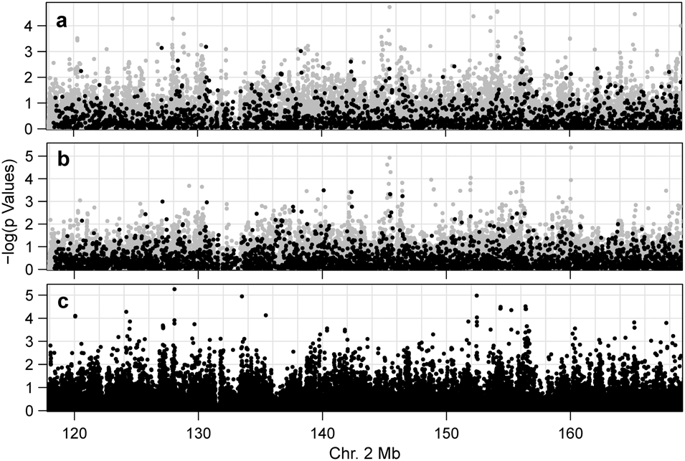当前位置:
X-MOL 学术
›
Genes. Immun.
›
论文详情
Our official English website, www.x-mol.net, welcomes your feedback! (Note: you will need to create a separate account there.)
Fine-mapping analysis of a chromosome 2 region linked to resistance to Mycobacterium tuberculosis infection in Uganda reveals potential regulatory variants.
Genes and Immunity ( IF 5 ) Pub Date : 2018-08-13 , DOI: 10.1038/s41435-018-0040-1 Robert P Igo 1 , Noémi B Hall 1 , LaShaunda L Malone 2 , Jacob B Hall 1, 3 , Barbara Truitt 1 , Feiyou Qiu 1 , Li Tao 4 , Ezekiel Mupere 1, 5, 6 , Audrey Schnell 1 , Thomas R Hawn 7 , William S Bush 1 , Moses Joloba 8 , W Henry Boom 2, 5 , Catherine M Stein 1, 2, 5
Genes and Immunity ( IF 5 ) Pub Date : 2018-08-13 , DOI: 10.1038/s41435-018-0040-1 Robert P Igo 1 , Noémi B Hall 1 , LaShaunda L Malone 2 , Jacob B Hall 1, 3 , Barbara Truitt 1 , Feiyou Qiu 1 , Li Tao 4 , Ezekiel Mupere 1, 5, 6 , Audrey Schnell 1 , Thomas R Hawn 7 , William S Bush 1 , Moses Joloba 8 , W Henry Boom 2, 5 , Catherine M Stein 1, 2, 5
Affiliation

|
Tuberculosis (TB) is a major public health burden worldwide, and more effective treatment is sorely needed. Consequently, uncovering causes of resistance to Mycobacterium tuberculosis (Mtb) infection is of special importance for vaccine design. Resistance to Mtb infection can be defined by a persistently negative tuberculin skin test (PTST-) despite living in close and sustained exposure to an active TB case. While susceptibility to Mtb is, in part, genetically determined, relatively little work has been done to uncover genetic factors underlying resistance to Mtb infection. We examined a region on chromosome 2q previously implicated in our genomewide linkage scan by a targeted, high-density association scan for genetic variants enhancing PTST- in two independent Ugandan TB household cohorts (n = 747 and 471). We found association with SNPs in neighboring genes ZEB2 and GTDC1 (peak meta p = 1.9 × 10-5) supported by both samples. Bioinformatic analysis suggests these variants may affect PTST- by regulating the histone deacetylase (HDAC) pathway, supporting previous results from transcriptomic analyses. An apparent protective effect of PTST- against body-mass wasting suggests a link between resistance to Mtb infection and healthy body composition. Our results provide insight into how humans may escape latent Mtb infection despite heavy exposure.
中文翻译:

乌干达与结核分枝杆菌感染抗性相关的2号染色体区域的精细映射分析揭示了潜在的调控变异。
结核病(TB)是世界范围内的主要公共卫生负担,因此迫切需要更有效的治疗方法。因此,揭露对结核分枝杆菌(Mtb)感染产生抗药性的原因对于疫苗设计尤为重要。尽管生活在紧密和持续暴露于活动性结核病病例的情况下,但结核菌素皮肤试验持续阴性仍可确定对Mtb感染的抵抗力。虽然对Mtb的敏感性部分是由基因决定的,但为揭示抗Mtb感染的遗传因素所做的工作相对较少。我们在两个独立的乌干达TB家庭队列(n = 747和471)中,通过有针对性的高密度关联扫描检查了先前涉及我们全基因组连锁扫描的2q染色体上的区域,寻找增强PTST-的遗传变异。我们发现与两个样品均支持的邻近基因ZEB2和GTDC1(峰值meta p = 1.9×10-5)中的SNP相关。生物信息学分析表明,这些变体可能通过调节组蛋白脱乙酰基酶(HDAC)途径来影响PTST-,从而支持先前的转录组分析结果。PTST-对抗体质浪费的明显保护作用表明对Mtb感染的抵抗力与健康的身体成分之间存在联系。我们的结果提供了关于尽管暴露量很大但人类如何能够逃脱潜在的Mtb感染的见解。PTST-对抗体质浪费的明显保护作用表明对Mtb感染的抵抗力与健康的身体成分之间存在联系。我们的结果提供了关于尽管暴露量很大但人类如何能够逃脱潜在的Mtb感染的见解。PTST-对抗体质浪费的明显保护作用表明对Mtb感染的抵抗力与健康的身体成分之间存在联系。我们的结果提供了关于尽管暴露量很大但人类如何能够逃脱潜在的Mtb感染的见解。
更新日期:2019-11-18
中文翻译:

乌干达与结核分枝杆菌感染抗性相关的2号染色体区域的精细映射分析揭示了潜在的调控变异。
结核病(TB)是世界范围内的主要公共卫生负担,因此迫切需要更有效的治疗方法。因此,揭露对结核分枝杆菌(Mtb)感染产生抗药性的原因对于疫苗设计尤为重要。尽管生活在紧密和持续暴露于活动性结核病病例的情况下,但结核菌素皮肤试验持续阴性仍可确定对Mtb感染的抵抗力。虽然对Mtb的敏感性部分是由基因决定的,但为揭示抗Mtb感染的遗传因素所做的工作相对较少。我们在两个独立的乌干达TB家庭队列(n = 747和471)中,通过有针对性的高密度关联扫描检查了先前涉及我们全基因组连锁扫描的2q染色体上的区域,寻找增强PTST-的遗传变异。我们发现与两个样品均支持的邻近基因ZEB2和GTDC1(峰值meta p = 1.9×10-5)中的SNP相关。生物信息学分析表明,这些变体可能通过调节组蛋白脱乙酰基酶(HDAC)途径来影响PTST-,从而支持先前的转录组分析结果。PTST-对抗体质浪费的明显保护作用表明对Mtb感染的抵抗力与健康的身体成分之间存在联系。我们的结果提供了关于尽管暴露量很大但人类如何能够逃脱潜在的Mtb感染的见解。PTST-对抗体质浪费的明显保护作用表明对Mtb感染的抵抗力与健康的身体成分之间存在联系。我们的结果提供了关于尽管暴露量很大但人类如何能够逃脱潜在的Mtb感染的见解。PTST-对抗体质浪费的明显保护作用表明对Mtb感染的抵抗力与健康的身体成分之间存在联系。我们的结果提供了关于尽管暴露量很大但人类如何能够逃脱潜在的Mtb感染的见解。



























 京公网安备 11010802027423号
京公网安备 11010802027423号